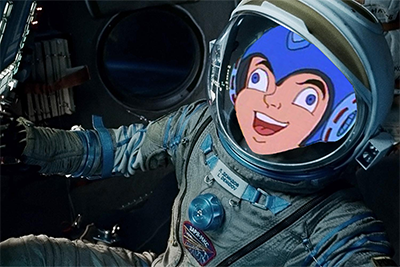Why “Gravity” is Wrong (And Why That’s Okay)

If there is one thing Hollywood isn’t known for being good at, it’s physics. That probably goes without saying, seeing as how just about any movie you watch commits horrendous crimes against the laws of physics, and this is particularly evident in any movie involving space, such as the 1998 film Armageddon- considered to be so unrealistic that it is rumored to be used by NASA as a training video, where they would have to point out as many of the 168 errors they can find.
Compared to many other science fiction movies, Gravity is quite down to Earth (metaphorically speaking). Dr. Ryan Stone (Sandra Bullock) discovers the implications of angular momentum the hard way as she desperately flails about, trying in vain to stop her rotation (without outside forces, she would tumble forever). When she picks up a fire extinguisher aboard the International Space Station, Newton’s third law comes into play as she (quite literally) rockets backwards. Best of all, the movie avoids the annoyingly common (and false) cliché of depressurization causing people to explode (it can happen at extreme pressure changes, but the difference between one atmosphere to a vacuum is not enough).
But nothing is perfect. Gravity has numerous physical and historical inaccuracies, although they are not blindingly obvious. The biggest one would be the relative ease in which the astronauts went from the Hubble Space Telescope to the International Space Station. Having discovered with Dr. Stone that the remaining crew had been killed by debris, Matt Kowalski (George Clooney) tells Dr. Stone of his plan: using his Manned Maneuvering Unit (space jetpack gizmo), they would travel to the International Space Station and try to escape in one of the docked spacecraft.
The problem with this in real life, however, is that Hubble and the ISS are almost never nearby in their orbits, and even when they are at their closest, they zip past each other at about 3000 m/s (7000 mph), due to their orbits being in separate inclinations relative to the equator. For an astronaut (or anything else) to travel to the ISS from Hubble, they would need to match their speed with that of the ISS, canceling out their relative velocity. However, the Manned Maneuvering Unit is only meant to be used between two spacecraft in close proximity with nearly matching speeds, and only carries enough fuel to change speed by up to 80 m/s (180 mph), barely enough to generate more than 1/40th of the required speed. Even if they still had the Space Shuttle, and the Shuttle had a full tank of fuel in its Orbital Maneuvering System, it would still only be able to generate 1/10th of what it would need to.
In fact, this was actually the source of some discussion when NASA flew the last shuttle mission to Hubble. After the Columbia disaster, it was required that all shuttle missions be flown to the ISS, such that if there was any damage to the heat shield tiles, they would still have a way back home. However, after a petition and much debate, an exception was made for the one mission, although another shuttle was prepared in order to rescue them in the event of an emergency.
There were a few other minor errors, such as the tears floating off of Dr. Stone’s face (surface tension would keep them pooled on her eye), GPS satellites being hit by the debris (GPS satellites orbit higher than most satellites, so they would probably be safe), as well as historical errors, such as the Space Shuttle (retired in 2011), the ISS (scheduled to be retired around 2020) and the Chinese space station Tiangong (scheduled to begin assembly in 2020) existing simultaneously. The problem with a chain reaction of space debris is, on the other hand, a very real issue, sometimes referred to as “Kessler Syndrome”.
However, these errors do not make it a bad movie. It is an excellent movie, with very nice effects, a very emotional performance, memorable dialogue, and an exciting plot. In fact, the movie is probably better off with the errors, and the writers were probably aware of them when they wrote it. By violating physics to allow the astronauts to easily move from spacecraft to spacecraft, as well as placing them in the same time frame, they are able to allow for a much wider array of sets, ranging from the interior of the derelict shuttle, to the interior of the abandoned ISS, to the cockpit of a Soyuz that was left behind. Wherever there is an error, one will realize that making that part be correct would make for a worse movie, which would imply that the writers intentionally made the “mistakes” when they felt they were necessary to make for a good film, and the result is that the accurate details far outnumber the inaccurate details. As a whole, the movie is an excellent depiction of space and is, for the most part, realistic.
The only thing I do take issue with is the event that started the debris problem in the first place: a Russian anti-satellite missile test. Anti-satellite missile tests are terrible ideas. Seriously, who authorized that? It’s not like the president of Russia is some sort of James Bond villain … oh, right. Vladimir Putin.








